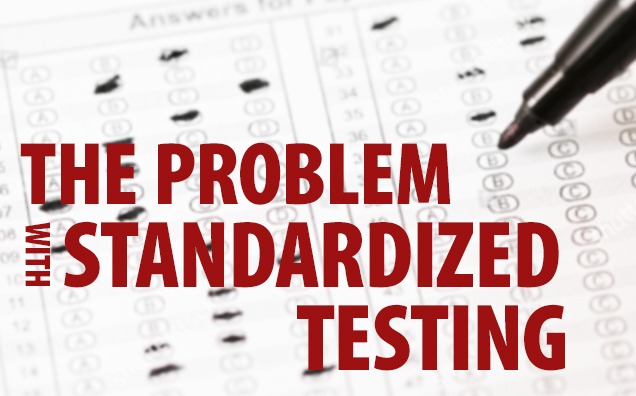The Problem With Standardized Testing

Originally published October 2017
By Meagan Gillmore
Many teachers acknowledge that comparative assessment techniques, such as standardized tests, often measure performance more than knowledge. Students may recite information, but have little ability to apply it to their lives. This can frustrate teachers, who may feel these systems can’t be changed. Some school boards are asking governments to suspend administering standardized tests. But even if they can’t reform education policies overnight, teachers have more ability to change things than they realize, says one New Zealand academic.
“We’ve been taught as a profession to become passive, to go, ‘Well we can’t undo this’,” says Welby Ings, a design professor at Auckland University of Technology and former K-12 classroom teacher in New Zealand. “But actually, it’s our professional responsibility to question things that are not right.”
Ings encourages teachers to become what he calls “positively disobedient.” He doesn’t think teachers should be disruptive without reason. Instead, they need to be creative and challenge rituals to help students learn. Teachers may want to do this, but not know how. That’s one of the reasons Ings recently wrote a book on the subject, Disobedient Teaching. He uses examples from his career to give what he calls “an arm around the shoulder” for teachers who need encouragement in their jobs.
There are many problems with standard tests, which Ings calls “a very blunt and ineffective tool for understanding learning.” Diagnostic assessments help teachers understand what students know and how they learn. Comparative assessments, however, can create artificial hierarchies that promote unnecessary competition, and discourage students from learning, he says.
Not all students are affected by traditional assessments in the same way. They can hinder students differently, depending on how people learn, says Ings.
The demand to produce answers immediately can disadvantage reflective students who need time to think about a concept from many different perspectives before giving a response. Other students become anxious when taking tests and make mistakes even if they know the material. The examination room can be like a “meat grinder” to them, says Ings. “They need a certain amount of grace around their thinking so they can actually apply very delicate and nuanced approaches to working with knowledge”.
Students who excel, however, at these assessments are vulnerable too, says Ings. They may be so focused on the grade they neglect to look at feedback, or consider how they can improve. They can lose respect for the value of learning.
Ings encourages teachers to create a classroom culture that encourages critical self-assessment. This doesn’t need to happen through long, complicated exercises. It can be as simple as asking students questions about what they liked about their work and how they would change what they did if they had more time. Or it could mean having students review each other’s work. Ings often had his high-school students review two classmates’ essays. They would say what they thought was good about each piece, and what they thought could be improved. This is a smaller-scale version of the peer-review process in higher levels of academia.
Other times, Ings had students review their assignments before he sent them home with reports. He would give them time to look through their work, and ask them to pick out the assignment they liked most. They would scan the assignment and write about what they liked about it, what they learned while they were working on it, and what they planned to do next. It took about an hour, he said, and it helped students learn to think critically and assess their own work.
Self-assessment and reflection are skills students are going to need when they leave school, regardless of what professions they may acquire. Good marks don’t create respect or meaningful relationships, says Ings. “Nobody will fall in love with you because you got 86 (on an assignment).” What those outside of school, like future employers, really want to know about is how people think and act.
Ings acknowledges creating these classroom environments can be difficult. The high priority placed on standard assessments can be dangerous for teachers, and the quality of education they provide. They may be tempted to skew marks to be higher. Or, they could emphasize parts of the curriculum they know will be on tests and ignore portions that don’t often get evaluated. In these ways, traditional tests can encourage teachers to become “corrupt.”
Ings encourages teachers and administrators who want to become positively obedient to connect with similar professionals. Sometimes, teachers want to be heroes, but no change can come by individuals working alone, he says. When people become isolated, there’s no one else giving them resources to help them. This can make it easier to become passive—because they don’t see others changing things, they may find it hard to believe they can change things too. Ultimately, this can produce cynicism, a belief that nothing can change.
Passionate teachers, those for whom teaching is a calling connected with their identity, need this community even more, says Ings. They often bring a humanity to teaching that allows them to connect with diverse and difficult students. But because they’re so invested in their students, they are vulnerable to getting hurt deeply. They want to help, so they may agree to do too many things. This can cause them to burn out, says Ings, who admits he left teaching twice because of these types of problems. It’s important for teachers to have friends who will tell them when they’re taking on too much.
Supportive communities can help encourage belief, and that’s crucial.
“Don’t give up belief,” says Ings, “because it’s only through belief that you can change things.”
Meagan Gillmore is a freelance writer in Toronto, ON.
